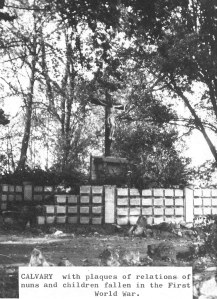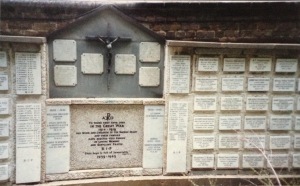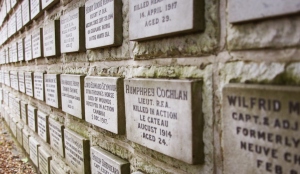Earlier this year Putney Library ran a series of behind-the-scenes tours in response to a request from our Friends’ group. In preparation for these I visited Wandsworth Heritage Service, hoping to draw on the wealth of archive material there to add a historical dimension to the tours. It was a chance sighting in one of the archive items – the library’s salaries book for the 1910s – which set me on the trail of William John Mills.
The salaries book [1] is a handwritten week-by-week record of the payments made to each staff member, signed to confirm receipt. W.J. Mills appears in the very first entry in the book, in April 1910. Then aged fifteen, and employed as a junior assistant, he was paid 9s 6d per week. By the summer of 1914 he was earning 17s 3d, but from September onwards he is recorded as being paid 10s 3d, with the added note “whole pay less army pay while on military service.” His mother, Ada, signed on his behalf. (As noted in a previous blog post [2], the Council had resolved to make up the difference in salaries of those staff serving with the military.)

Entry in the Putney Library Salaries book
This pattern continued through to 2nd June 1917, when Mills’s name is crossed through in red, and payments ceased. Fearing the worst, I asked the heritage staff if they could find any record of his death. The result was rather surprising, as the following entry was found in the Council minutes [3] over a year later, on 16 October 1918:
Death of Lieut W J Mills, Northumberland Fusiliers, attached RAF on 3rd September, former junior assistant Putney Library – shot while flying on Western Front.
I was able to locate Mills’s RAF service record [4], which had been digitised and was available for download from the National Archives. His more substantial army record [5] was not, but unlike many it had survived in hard-copy and I was able to view it at Kew. From these records we now know the following of the life and career of William Mills:
He was born on 6th October 1894, the eldest son of John and Ada Mills. In 1914 the family was living at 59 Mexfield Road, East Putney [6]. On 3rd September 1914, just a month after the outbreak of war, William enlisted as a rifleman – service no. 2648 – in the18th Battalion, London Regiment (London Irish Rifles). A territorial force, his unit was garrisoned in the UK throughout 1914 & 1915, but in April 1916 they embarked to Le Havre to join the British Expeditionary Force in France. William’s casualty record reports that in May he was hospitalised with measles. Then, on 28th June he was wounded in action: a gunshot wound to the forehead, but he recovered to return to his unit on 16th July.
On 28th October he was promoted to Lance Corporal, and just weeks later, in December 1916, he returned from France to take up place at officer cadet school (at Fermoy in Ireland), which led on 26th April 1917 to his appointment as Temporary 2nd Lieutenant with 20th Bn. Northumberland Fusiliers (1st Tyneside Scottish) [7]. As an officer, his service pay now exceeded his former council wage, hence the cancelled entry in the salaries book.
Mills spent the remainder of 1917 as an infantry officer, with his unit again garrisoned in the UK. Then, in early 1918, he was attached to the fledgling Royal Air Force. He trained as an observer and gunner before returning to France in April 1918 to join No. 10 Squadron, RAF. It was there that he was wounded on 3rd September (four years to the day after he enlisted), and he died from his wounds the following day. His death was recorded in the minutes of the Putney Library sub-committee [8]:

Putney Library Sub-Committee minute book
Death of Lieut. W.J. Mills
The Librarian reported that Mr. W.J. Mills was a junior
assistant in the Library until September 3rd 1914 when he joined His Majesty’s forces as a private in the London Irish Regiment [sic] later obtaining a commission in the Northumberland Fusiliers. On September 3rd 1918 while attached to the Royal Air Force as an observer he was shot while flying behind the German lines and died from wounds on September 4th 1918.
Resolved that the Committee received the sad information with deepest regret and that the Librarian be instructed to report the matter to the Libraries’ Committee. [8]
This in turn led to the Council minute noted earlier. Mills is buried at the British military cemetery at Esquelbecq in northern France [9].
The Mills family remained in Mexfield Road: the electoral register lists Ada at the address until 1947. William’s youngest brother Frank appears in the last register before the outbreak of war in 1939 but does not return afterwards, although Ancestry [10] records that he died in 1995 at the age of 93.
In 1923 the Library Association commissioned a roll of honour in memory of the British librarians – over 80 in all – lost during the Great War. This memorial is now located at the British Library, as are a number of photographs of those recorded on it, including William Mills [11].
Terry Day, Putney Library
References:
[1] MBW/5/6/16
[2] https://ww1wandsworth.wordpress.com/2014/10/06/6-12-october-1914-rifle-ranges-and-recruits/
[3] MBW/1
[4] National Archives AIR/76/349
[5] National Archives WO 339/82293
[6] The 1911 Census records that the Mills family then lived at an address in Stanbridge Road.
[7] Army List, December 1917, 944f.
[8] MBW/5/6/11
[9] http://www.cwgc.org/find-war-dead/casualty/25340/MILLS,%20WILLIAM%20JOHN A photograph of the gravestone can be viewed at http://twgpp.org/information.php?id=3064762 Puzzlingly, both sites list his unit as 20 Squadron RAF although his service record clearly shows 10 Squadron.
[10] http://search.ancestrylibrary.com/cgi-bin/sse.dll?new=1&gsfn=frank+brigginshaw&gsln=mills&rank=1&gss=angs-g&mswpn__ftp=&msbdy=1902&pcat=ROOT_CATEGORY&h=832229&db=ONSDeath93&indiv=1&ml_rpos=1
[11] https://m.facebook.com/britishlibrary/photos/a.10150448376867139.414095.8579062138/10150471969397139/?type=3&theater
 The visit lasted two and a half hours, during which the King and Queen visited almost every ward. The Borough News notes that the wards have passages over a mile long, and there were additional wards built to the side of the Royal Victoria Patriotic building as well (forming what was known as “C block”).
The visit lasted two and a half hours, during which the King and Queen visited almost every ward. The Borough News notes that the wards have passages over a mile long, and there were additional wards built to the side of the Royal Victoria Patriotic building as well (forming what was known as “C block”).




